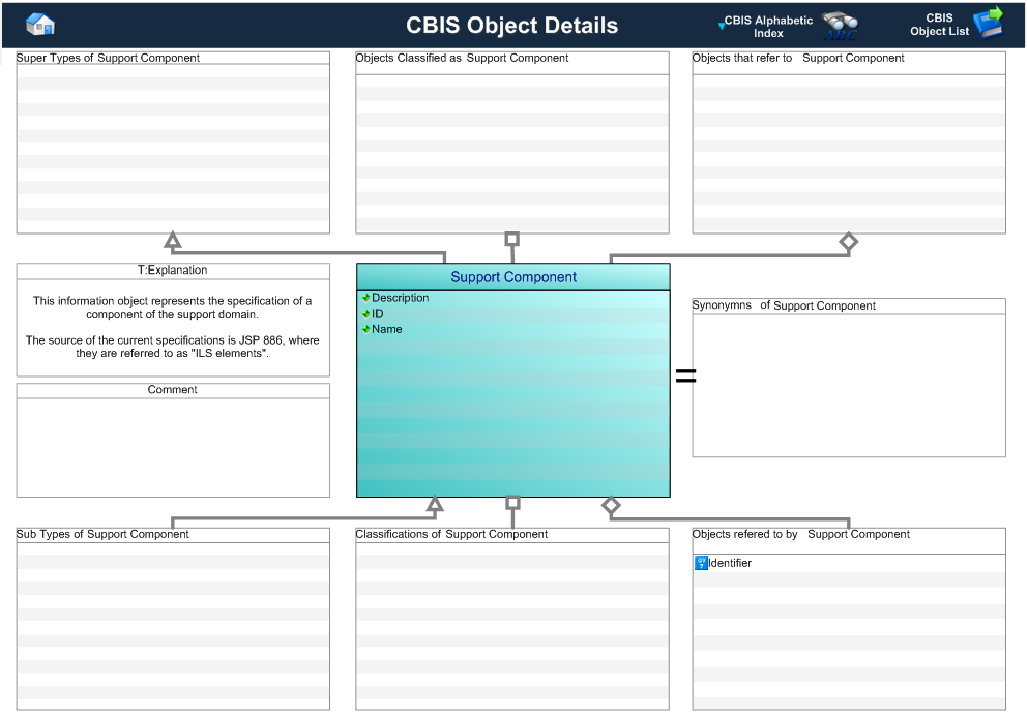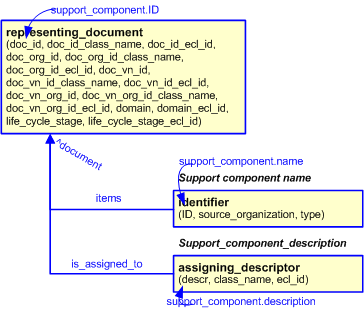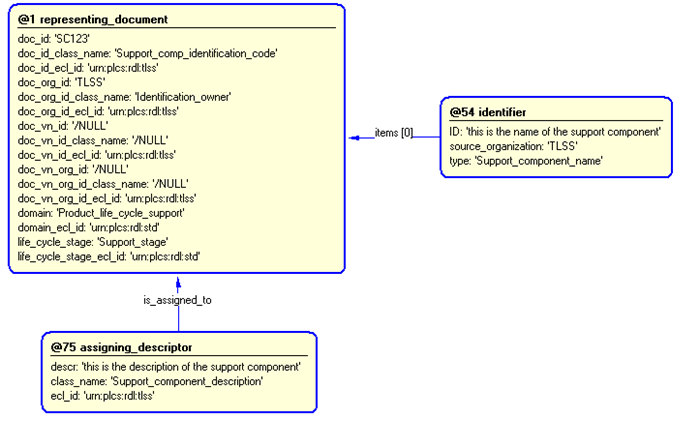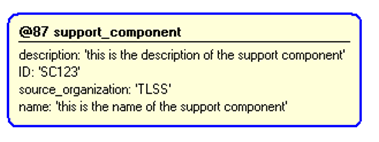Template:— support_component (supp_comp)
Context:— UK_Defence |
Date: 2009/04/17 11:50:21
Revision: 1.4
|
This section specifies the template support_component.
NOTE
The template has been defined in the context of
UK_Defence.
Refer to the business context for details of related templates.
NOTE
An explanation of a template and the associated instantiation path is
provided in the
Template overview
section.
This template describes how to represent the specification of a component
of the support domain. The source of the current specifications is
JSP 886, where they are referred to as "ILS elements".
The support component business object is used by those UK_Defence Data
Exchange Specifications that require information about the specification
of a component of the support domain.
Figure 1 — Graphical Representation for Business Object Support Component
Support Component:
The definition of a Support Component object is:
Data about the specification of a component of the support domain.
|
Attribute name
|
Attribute description
|
Attribute type
|
Optionality
|
| Description |
This is the description of the support component. |
Intrinsic |
Mandatory |
| ID |
This is the Identifier of the support component. |
Identifier |
Mandatory |
| Name |
This is the name of the support component.
Typical components (distilled from JSP 886 Volume 7 Part 1) include:
"Asset management"
"Commercial and contract management"
"Computer and software support"
"Configuration management"
"Disposal"
"Environmental impact"
"Facilities, infrastructure and services"
"Information management"
"Interface with design"
"Maintainability engineering"
"Maintenance engineering"
"Manpower and human factors"
"Obsolescence"
"Packaging, handling, storage and transportation"
"Quality management"
"Reliability engineering"
"Risk management"
"Safety"
"Supply support"
"Support and test equipment"
"Sustainability"
"Technical data, documentation and information"
"Technology management"
"Through life support performance monitoring"
"Through life costing"
"Through life planning"
"Training and training equipment / facilities"
"Whole life costing"
|
Intrinsic |
Mandatory |
Table 1 — Support Componentattribute details
The EXPRESS-G diagram in
Figure
2
shows the templates and EXPRESS entities that are required
to represent the template
"support_component".
The text highlighted in blue shows the template parameters.
Figure 2 — An EXPRESS-G representation of the Information model for support_component
The graphic for the template to be used in other EXPRESS-G diagrams
is shown in Figure
3
below.
Figure 3 — The graphical representation of the support_component template
The following input parameters are defined for this template:
This is the description of the support component.
This is the identifier of the support component.
The organization that created the associated identifier. Additionally
a Person or Information System could be defined when either of these are the source; see Identifier template.
This is the name of the support component..
The following reference parameters are defined for this template:
Allow the
Document
entity instantiated in this path to be referenced when this template is used.
Note: The
Document
entity can be referenced in a template path by:
%^target = $support_component.supp_comp%
where
target
is the parameter to which the
Document
is bound.
The following parameter combinations specify a uniqueness constraint:
Unique constraint: Support_component
Each instance of the
entity
(
Document)
within the data set shall be uniquely identified
by a combination of the following parameters on this
template (support_component) namely:
ID,
name.
The
instance is
referenced by the following template parameter:
supp_comp.
The instantiation path shown below specifies the entities that are to be
instantiated by the template.
A description of templates and the syntax for the instantiation path is
provided in the
Templates Help/Information section.
-- Instantiate a document /
representing_document(
doc_id=@ID,
doc_id_class_name='Support_comp_identification_code',
doc_id_ecl_id='urn:plcs:rdl:uk_defence',
doc_org_id=@source_organization,
doc_org_id_class_name='Identifier_owner',
doc_org_id_ecl_id='urn:plcs:rdl:uk_defence',
doc_vn_id='/NULL',
doc_vn_id_class_name='/NULL',
doc_vn_id_ecl_id='urn:plcs:rdl:uk_defence',
doc_vn_org_id='/NULL',
doc_vn_org_id_class_name='/NULL',
doc_vn_org_id_ecl_id='urn:plcs:rdl:uk_defence',
domain='Product_life_cycle_support',
domain_ecl_id='urn:plcs:rdl:std',
life_cycle_stage='Support_stage',
life_cycle_stage_ecl_id='urn:plcs:rdl:std')/
%^supp_comp = $representing_document.document%
-- Name (mandatory) /
identifier(
ID=@name,
source_organization=@source_organization,
type='Support_component_name',
items=^supp_comp)/
-- Instantiate a description /
assigning_descriptor(
descr=@description,
class_name='Support_component_description',
ecl_id='urn:plcs:rdl:uk_defence',
is_assigned_to=^supp_comp)/
The instance diagram in Figure
4
shows an example of the EXPRESS entities and templates that are instantiated by the template:
/support_component(name='this is the name of the support component', ID='SC123', source_organization='UK_Defence', description='this is the description of the support component')/
(an illustration of the consolidated support_component template is shown in
Figure
5 below.)
Figure 4 — Entities instantiated by support_component template
The instance diagram in
Figure
5
shows the graphic symbol for the template that is to be
used in other instance diagrams. The example template is:
/support_component(name='this is the name of the support component', ID='SC123', source_organization='UK_Defence', description='this is the description of the support component')/
Figure 5 — Instantiation of support_component template
Characterizations
No common characterizations of the template
support_component
have been identified. However, the ISO 10303-239 EXPRESS model
may enable other assignments to the entities instantiated by the template.




